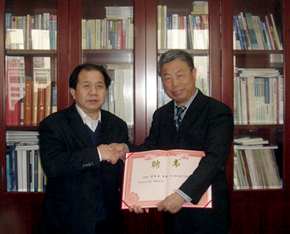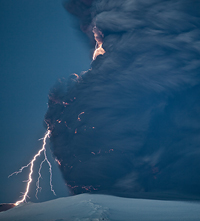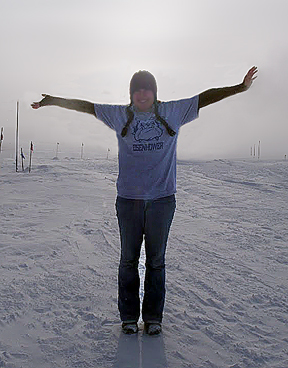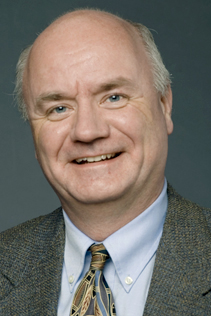News and Notes. . .
Faculty, Staff, and Student News
CHANGSHENG LI of the Complex Systems Research Center has been appointed director of the newly formed Shanghai Jiao Tong University Low-carbon Agricultural Research Center. An internationally renowned specialist in biogeochemistry, Li developed the Denitrification-Decomposition (DNDC) model that is used worldwide for the studies of carbon sequestration, trace gas emissions,
fertilizer efficiency, crop production, and nitrogen contamination in water. His appointment, the university announced, will help move the research center “toward an international advanced platform for low-carbon agricultural theoretical research and technology development.”
THE RESEARCH COMPUTING CENTER, in partnership with UNH’s Coastal Response Research Center and NOAA, developed a web-based tool, known as the Environmental Response Management Application (ERMA®), that is being recognized as the one-stop shop for detailed near-real-time information about the response to the Deepwater Horizon BP oil spill. “This has been an incredible project for us to work on,” says Patrick Messer, director of UNH’s Research Computing Center based at EOS. “They came to us with a problem and we all worked together on how to solve it. It allowed my staff, primarily Philip Collins and Robert St. Lawrence, to actively participate in the design of the software, which was very rewarding. We may not be down on the coast, but it feels good to know we’re helping to make a difference.”
RACHEL FEENEY, communication and information coordinator for the Northeast Consortium, published a paper in Marine and Coastal Fisheries: Dynamics, Management, and Ecosystem Science entitled “Assessing Stakeholder Perspectives on the Impacts of a Decade of Collaborative Fisheries Research in the Gulf of Maine and Georges Bank.” The paper is a social science assessment of the impacts of collaborative fisheries research funding programs in New England, the Northeast Consortium included.
OPAL RESEARCH SCIENTIST Chris Hunt published a paper in Estuaries and Coasts entitled “Contrasting Carbon Dioxide Inputs and Exchange in Three Adjacent New England Estuaries.” Joe Salisbury and Doug Vandemark are co-authors.
ALEX PRUSEVICH
reports that the eruption of the Eyjafjallajökull volcano in Iceland was closely watched by the Volcanology Research Group at CSRC, which has an ongoing NSF-funded project to study volcanic ash. The project is titled "Ash Particles and the Bubbles that Make Them: Measuring Bubble Size from Ash Fragments for New Insights Regarding Eruption Dynamics." The project probes why some volcanoes erupt with so much ash, as has Eyjafjallajökull, while many others erupt with mostly lava flows.
PH.D. CANDIDATE Dara Feddersen of the Climate Change Research Center has received a NASA Graduate Student Researchers Program (GSRP) three-year fellowship. The fellowship also includes a 10-week-per-year in-residence research opportunity at NASA Langley Research Center in Hampton, Virginia. Fedderson is conducting research on atmospheric mercury with CCRC director Bob Talbot and Howard Mayne from the Department of Chemistry.
Ph.D. STUDENT Matthew Vadeboncoeur of CSRC will attend a conference being hosted by the Smithsonian Institution's Center for Tropical Forest Science in Kuala Lumpur, Malaysia. The conference will bring together scientists and information managers to analyze data from a series of large forest dynamics plots across Asia. Vandeboncoeur’s research focuses primarily on biogeochemical cycles in temperate forests. His advisor is Erik Hobbie.
Beginning early in June, Ph.D. student Chelsea Corr spent three weeks at Summit Station in Greenland relieving her EOS advisor Jack Dibb in making measurements of nitric and nitrous acids as part of collaborative snow photochemistry research with Brown University and Georgia Tech scientists. Says Corr, “We're also interested in measuring the halogen bromine as we hypothesize that it may be a large player in the mismatch between modeled processes in the snow and processes that are measured.” Corr, who participated in UNH’s Transforming Earth System Science Education (TESSE) program, blogged from Summit with 6th graders in Wycoff, New Jersey with whom she has been working this past year.
Physics undergraduate and EOS student researcher Joshua Stawarz was awarded a Goldwater Scholarship. Nationwide, fewer than 300 students in all areas of science and engineering are awarded the prestigious scholarship. Stawarz, who will be a senior this coming fall, is the author of six scientific papers. His latest paper titled "The Turbulent Cascade for High Cross-Helicity States at 1 AU" by Stawarz, Smith, Vasquez, Forman, and MacBride was published in The Astrophysical Journal in April 2010.
 |
| Changsheng Li, right |
THE RESEARCH COMPUTING CENTER, in partnership with UNH’s Coastal Response Research Center and NOAA, developed a web-based tool, known as the Environmental Response Management Application (ERMA®), that is being recognized as the one-stop shop for detailed near-real-time information about the response to the Deepwater Horizon BP oil spill. “This has been an incredible project for us to work on,” says Patrick Messer, director of UNH’s Research Computing Center based at EOS. “They came to us with a problem and we all worked together on how to solve it. It allowed my staff, primarily Philip Collins and Robert St. Lawrence, to actively participate in the design of the software, which was very rewarding. We may not be down on the coast, but it feels good to know we’re helping to make a difference.”
RACHEL FEENEY, communication and information coordinator for the Northeast Consortium, published a paper in Marine and Coastal Fisheries: Dynamics, Management, and Ecosystem Science entitled “Assessing Stakeholder Perspectives on the Impacts of a Decade of Collaborative Fisheries Research in the Gulf of Maine and Georges Bank.” The paper is a social science assessment of the impacts of collaborative fisheries research funding programs in New England, the Northeast Consortium included.
OPAL RESEARCH SCIENTIST Chris Hunt published a paper in Estuaries and Coasts entitled “Contrasting Carbon Dioxide Inputs and Exchange in Three Adjacent New England Estuaries.” Joe Salisbury and Doug Vandemark are co-authors.
ALEX PRUSEVICH
 |
|
Lightning and motion-blurred ash appear in this 15-second exposure taken 25 kilometers from the Eyjafjallajökull
volcano on April 18th, 2010. Photo used with permission.
© Olivier Vandeginste. |
PH.D. CANDIDATE Dara Feddersen of the Climate Change Research Center has received a NASA Graduate Student Researchers Program (GSRP) three-year fellowship. The fellowship also includes a 10-week-per-year in-residence research opportunity at NASA Langley Research Center in Hampton, Virginia. Fedderson is conducting research on atmospheric mercury with CCRC director Bob Talbot and Howard Mayne from the Department of Chemistry.
Ph.D. STUDENT Matthew Vadeboncoeur of CSRC will attend a conference being hosted by the Smithsonian Institution's Center for Tropical Forest Science in Kuala Lumpur, Malaysia. The conference will bring together scientists and information managers to analyze data from a series of large forest dynamics plots across Asia. Vandeboncoeur’s research focuses primarily on biogeochemical cycles in temperate forests. His advisor is Erik Hobbie.
 |
| Chelsea Corr |
Physics undergraduate and EOS student researcher Joshua Stawarz was awarded a Goldwater Scholarship. Nationwide, fewer than 300 students in all areas of science and engineering are awarded the prestigious scholarship. Stawarz, who will be a senior this coming fall, is the author of six scientific papers. His latest paper titled "The Turbulent Cascade for High Cross-Helicity States at 1 AU" by Stawarz, Smith, Vasquez, Forman, and MacBride was published in The Astrophysical Journal in April 2010.
by David Sims, Science Writer, Institute for the Study of Earth, Oceans, and Space. Published in Summer 2010 issue of EOS .

